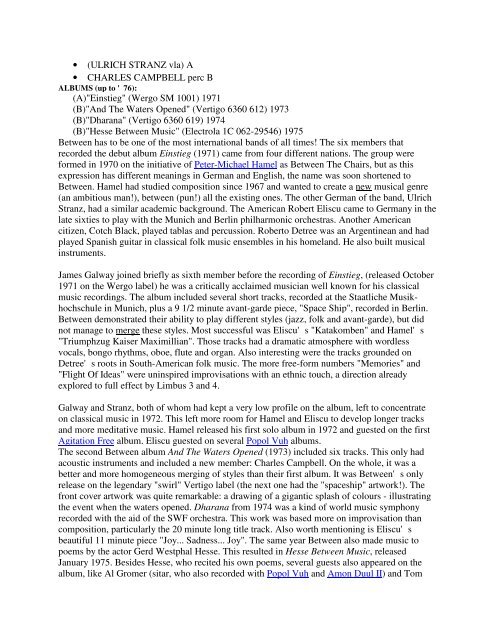Cosmic Dreams at Play - Stoned Circus radio show - Free
Cosmic Dreams at Play - Stoned Circus radio show - Free
Cosmic Dreams at Play - Stoned Circus radio show - Free
Create successful ePaper yourself
Turn your PDF publications into a flip-book with our unique Google optimized e-Paper software.
• (ULRICH STRANZ vla) A<br />
• CHARLES CAMPBELL perc B<br />
ALBUMS (up to '76):<br />
(A)"Einstieg" (Wergo SM 1001) 1971<br />
(B)"And The W<strong>at</strong>ers Opened" (Vertigo 6360 612) 1973<br />
(B)"Dharana" (Vertigo 6360 619) 1974<br />
(B)"Hesse Between Music" (Electrola 1C 062-29546) 1975<br />
Between has to be one of the most intern<strong>at</strong>ional bands of all times! The six members th<strong>at</strong><br />
recorded the debut album Einstieg (1971) came from four different n<strong>at</strong>ions. The group were<br />
formed in 1970 on the initi<strong>at</strong>ive of Peter-Michael Hamel as Between The Chairs, but as this<br />
expression has different meanings in German and English, the name was soon shortened to<br />
Between. Hamel had studied composition since 1967 and wanted to cre<strong>at</strong>e a new musical genre<br />
(an ambitious man!), between (pun!) all the existing ones. The other German of the band, Ulrich<br />
Stranz, had a similar academic background. The American Robert Eliscu came to Germany in the<br />
l<strong>at</strong>e sixties to play with the Munich and Berlin philharmonic orchestras. Another American<br />
citizen, Cotch Black, played tablas and percussion. Roberto Detree was an Argentinean and had<br />
played Spanish guitar in classical folk music ensembles in his homeland. He also built musical<br />
instruments.<br />
James Galway joined briefly as sixth member before the recording of Einstieg, (released October<br />
1971 on the Wergo label) he was a critically acclaimed musician well known for his classical<br />
music recordings. The album included several short tracks, recorded <strong>at</strong> the Sta<strong>at</strong>liche Musikhochschule<br />
in Munich, plus a 9 1/2 minute avant-garde piece, "Space Ship", recorded in Berlin.<br />
Between demonstr<strong>at</strong>ed their ability to play different styles (jazz, folk and avant-garde), but did<br />
not manage to merge these styles. Most successful was Eliscu's "K<strong>at</strong>akomben" and Hamel's<br />
"Triumphzug Kaiser Maximillian". Those tracks had a dram<strong>at</strong>ic <strong>at</strong>mosphere with wordless<br />
vocals, bongo rhythms, oboe, flute and organ. Also interesting were the tracks grounded on<br />
Detree's roots in South-American folk music. The more free-form numbers "Memories" and<br />
"Flight Of Ideas" were uninspired improvis<strong>at</strong>ions with an ethnic touch, a direction already<br />
explored to full effect by Limbus 3 and 4.<br />
Galway and Stranz, both of whom had kept a very low profile on the album, left to concentr<strong>at</strong>e<br />
on classical music in 1972. This left more room for Hamel and Eliscu to develop longer tracks<br />
and more medit<strong>at</strong>ive music. Hamel released his first solo album in 1972 and guested on the first<br />
Agit<strong>at</strong>ion <strong>Free</strong> album. Eliscu guested on several Popol Vuh albums.<br />
The second Between album And The W<strong>at</strong>ers Opened (1973) included six tracks. This only had<br />
acoustic instruments and included a new member: Charles Campbell. On the whole, it was a<br />
better and more homogeneous merging of styles than their first album. It was Between's only<br />
release on the legendary "swirl" Vertigo label (the next one had the "spaceship" artwork!). The<br />
front cover artwork was quite remarkable: a drawing of a gigantic splash of colours - illustr<strong>at</strong>ing<br />
the event when the w<strong>at</strong>ers opened. Dharana from 1974 was a kind of world music symphony<br />
recorded with the aid of the SWF orchestra. This work was based more on improvis<strong>at</strong>ion than<br />
composition, particularly the 20 minute long title track. Also worth mentioning is Eliscu's<br />
beautiful 11 minute piece "Joy... Sadness... Joy". The same year Between also made music to<br />
poems by the actor Gerd Westphal Hesse. This resulted in Hesse Between Music, released<br />
January 1975. Besides Hesse, who recited his own poems, several guests also appeared on the<br />
album, like Al Gromer (sitar, who also recorded with Popol Vuh and Amon Duul II) and Tom


